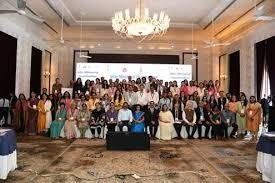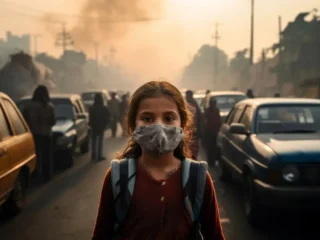India remains dedicated to nurturing and empowering its adolescents, as emphasized by Shri Apurva Chandra, the Union Health Secretary. Speaking at the launch of the “Economic Case for Investment in the Well-being of Adolescents in India” report, Shri Chandra highlighted India’s commitment to supporting the ambitions of its young population. This report builds on global findings from “Adolescents in a Changing World – The Case for Urgent Investment,” commissioned by the Partnership for Maternal, Newborn & Child Health (PMNCH) and released at the 77th World Health Assembly in Geneva. It showcases significant improvements in adolescent well-being in India, attributing these advancements to the Government’s extensive policies and programs.
Shri Apurva Chandra noted, “India has the largest population of adolescents in the world, 253 million strong, and growing. Our adolescents are the backbone of our future, embodying the promise of a vibrant and progressive nation.” He emphasized that India’s future depends on the health, education, and empowerment of its young people. By supporting adolescents, India aims to achieve its national and international development goals, including the Sustainable Development Goals (SDGs). The government is dedicated to creating an environment where adolescents can thrive, make informed decisions, and contribute meaningfully to society.
One of the key initiatives highlighted was the Rashtriya Kishor Swasthya Karyakram (RKSK), a dedicated program targeting 253 million adolescents, focusing on both genders, urban and rural populations, and those in and out of school. The program pays special attention to marginalized and underserved groups. Shri Chandra mentioned that significant strides have been made in advancing adolescent well-being in India, with initiatives such as the School Health and Wellness Programme under Ayushman Bharat, which aims to strengthen health promotion and disease prevention in schools. The Scheme for Promotion of Menstrual Hygiene aims to increase awareness and promote menstrual hygiene practices among adolescent girls.
Partnerships with non-governmental organizations, community leaders, and international agencies are crucial in reaching every adolescent, regardless of their socio-economic background, Shri Chandra said. He also announced the upcoming launch of the U-WIN platform, modeled after the Co-WIN platform used for COVID-19 vaccination. The U-WIN platform will store and digitize health records for every child, helping monitor and address health challenges.
Shri Anandrao V. Patil, Additional Secretary, Ministry of Education, highlighted increased budgetary allocations for school education and modifications to the school curriculum. Significant efforts are being made to improve skills after the 6th grade and to support children with special needs, girl education, and mid-day meals. Most schools have started promoting menstrual hygiene, and the government is reaching out to areas where such initiatives have not yet been implemented. The National Adolescent Health Programme is also being implemented in government schools across India.
Shri Rajat Khosla, Executive Director of PMNCH, pointed out that adolescents make up 1.5 billion people worldwide, with one-fifth of them residing in India. He commended the Indian Government’s initiatives but also noted the challenges adolescents face, such as violence and early pregnancies. He emphasized the economic and social benefits of investing in adolescents, highlighting the Rs. 2 lakh crore budgetary allocation made by the Indian Government towards adolescent well-being in the Union Budget 2024-25. “India is a beacon of hope not only to LMIC but to other countries across the world. India has shown that empowerment of adolescents can be done”, he remarked.
Dr. Rodrigo H. Ofrin, WHO Representative to India, noted that the Government of India is taking various initiatives to reap its demographic dividends. “The country has achieved important triumphs in various health indicators,” he said. Convergence in various government schemes complements efforts to ensure adolescent well-being. Investing in adolescents is a smart investment in the nation’s future, and achieving the SDGs would not be possible without it.
Prof. Bruce Rasmussen, Director of the Victoria Institute of Strategic Economic Studies at Victoria University, presented key findings from the Investment Case for Adolescent Health & Well-being. He explained that India’s adolescent population, the largest in the world, will likely remain its largest ever. He outlined five domains of adolescent well-being: agency and resilience; safety and supportive environment; good health and nutrition; learning, competence, education, skills, and employability; and connectedness, positive values, and contribution to society. He highlighted the significant progress India has made in these areas. Prof. Rasmussen also presented a cost-benefit analysis showing how government interventions in education, skill development, and reducing child marriage and road accidents can significantly boost GDP.
Dr. Yatan Pal Singh Balhara, Professor of Psychiatry at AIIMS New Delhi, emphasized the growing focus on mental health in India, as seen in the recent Economic Survey. Dr. Reena Yadav, Director and Head of the Department of Obstetrics and Gynecology at Lady Hardinge Medical College, stressed the importance of education and awareness for adolescents, particularly regarding sexual and reproductive health issues.
Ms. Priya Rathore, a Youth Representative from Rajasthan, shared her experiences working with adolescent women facing challenges like child marriage. She highlighted the need for increased monitoring and evaluation of government support in rural and economically backward areas, as well as the importance of raising awareness about menstrual hygiene among adolescents.
Smt. Aradhana Patnaik, Additional Secretary and MD (NHM) of the Health Ministry, and other senior officials of the Union Health Ministry, were present at the event.







